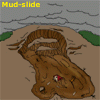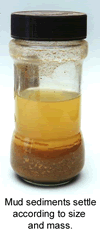 Once
weathering has broken down rocks, the resulting particles are picked up
and transported by erosion. The eroded material will eventually be dropped
by the eroding agent in a new place. This last part of the process is
called deposition.
Once
weathering has broken down rocks, the resulting particles are picked up
and transported by erosion. The eroded material will eventually be dropped
by the eroding agent in a new place. This last part of the process is
called deposition.
This topic investigates what happens to the material after being carried by the five agents of erosion and the landscape features formed in the process.
Erosion and deposition
 Deposition
occurs when the eroding agent, whether it be gravity, ice, water, waves
or wind, runs out of energy and can no longer carry its load of eroded
material. The energy available to the erosion agents comes from gravity,
or in the case of wind, the Sun. While the mountain slopes are steep,
there is plenty of gravitational energy available to move the eroding
material.
Deposition
occurs when the eroding agent, whether it be gravity, ice, water, waves
or wind, runs out of energy and can no longer carry its load of eroded
material. The energy available to the erosion agents comes from gravity,
or in the case of wind, the Sun. While the mountain slopes are steep,
there is plenty of gravitational energy available to move the eroding
material.
Sooner or later the glacier or river will reach more gently sloping ground or even flat plains and the energy that is transporting the eroded particles is reduced. It is at this stage that deposition becomes the dominant process, building up low lying areas and creating new land.
Deposition from the five agents of erosion will now be further investigated.
Gravity
 A
landslide or mud slide usually occurs quickly, with the slide coming to
a halt in a matter of minutes, leaving an area of destruction at the base
of the slope affected. Land slips occur over longer time periods, with
the movement often occurring over times too long for us to observe. In
both cases, the transported and unstable rocks and soil are now subjected
to more erosion, with rain and water once more acting to erode and further
transport the deposited material.
A
landslide or mud slide usually occurs quickly, with the slide coming to
a halt in a matter of minutes, leaving an area of destruction at the base
of the slope affected. Land slips occur over longer time periods, with
the movement often occurring over times too long for us to observe. In
both cases, the transported and unstable rocks and soil are now subjected
to more erosion, with rain and water once more acting to erode and further
transport the deposited material.
Water erosion deposits
 Probably
the most recognisable forms of deposition from water erosion are flood
plains and river deltas. Other features of rivers such as, rocky river
beds in mountain valleys and ox bow lakes on the plains are also the result
of deposition of material.
Probably
the most recognisable forms of deposition from water erosion are flood
plains and river deltas. Other features of rivers such as, rocky river
beds in mountain valleys and ox bow lakes on the plains are also the result
of deposition of material.
Material deposited by a river is called sediment and the type of sediment deposited is directly related to the amount of energy in the flowing water. The first sediments to be dropped by a river as it loses energy are the larger heavy rocks, progressively followed by smaller pebbles, sand and finally the fine silts.
This can be modelled quite easily. Mix some small stones, sand and mud with water in a plastic canister or PET softdrink bottle. Place a lid on the bottle and shake. Allow the bottle to stand and watch as the sediments settle out - rocks first, followed by sand and then finer and finer silts. The addition of 10mL of bleach in the water will prevent fungal and algae growth in the bottle, which can then be kept for years.
Ice erosion deposits
![]() The
most visible deposits left by glaciers are called moraines and outwashes.
Moraines tend to consist of large chunks of broken rock left at the base
and sides of the glacier as it melts, receding up its valley. Finer material
is carried in the rivers that form when the glacial ice melts. The deposits
of these rivers look similar to normal river deposits. These deposits
are called outwashes. Glacial rivers are usually white with fine silt
known as "glacial milk".
The
most visible deposits left by glaciers are called moraines and outwashes.
Moraines tend to consist of large chunks of broken rock left at the base
and sides of the glacier as it melts, receding up its valley. Finer material
is carried in the rivers that form when the glacial ice melts. The deposits
of these rivers look similar to normal river deposits. These deposits
are called outwashes. Glacial rivers are usually white with fine silt
known as "glacial milk".
 Wind
erosion deposits
Wind
erosion deposits
Sand dunes are the most visible product of deposition by wind. With their
shape and orientation governed by the prevailing winds. Wind erosion is
capable of carrying fine dust for thousands of kilometres, before depositing
it again when the winds die down. For example, dust originating from Southern
Australia, and carried by a dust storm in early 2000, was found in New
Zealand! Much of this precious topsoil actually landed in the Tasman sea,
lost for perhaps millions of years, maybe until tectonic movement of the
Earth's crust raises this part of the ocean to form dry land again.
Wave erosion deposits
 The
material eroded from cliffs and shorelines is usually deposited nearby
as a beach or sand on the sea floor. The cycle of erosion and deposition
is an ongoing one with beach sand building up, only to be washed away
in a storm and deposited on another beach.
The
material eroded from cliffs and shorelines is usually deposited nearby
as a beach or sand on the sea floor. The cycle of erosion and deposition
is an ongoing one with beach sand building up, only to be washed away
in a storm and deposited on another beach.

|
Erosion by sea |
| Copyright owned by the State of Victoria (Department of Education and Early Childhood Development). Used with Permission. |
|
|||||||||||||||||||||||||||||||||||||||||||||||||||||||||||||||||||||||||||||||||||||